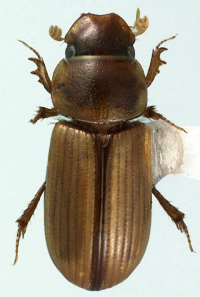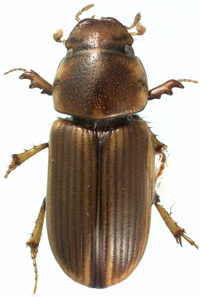
| . | |||
Erroneous records (Excerpt from: Smith, A. B. T. and P. E. Skelley. 2007. A review of the Aphodiinae (Coleoptera: Scarabaeidae) of southern South America. Zootaxa 1458: 1-80). |
|||
| . | |||
. Aidophus flaveolus (Harold, 1868) We consider the type locality “Chili” and the record from VII Región del Bío-Bío, Chile (Gutiérrez 1949) to be erroneous. The erroneous record of the type locality originated from the same paper (Harold 1868) and same batch of specimens (from the Kraatz collection) as the erroneous record of Odontopsammodius cruentus in Chile (species of Odontopsammodius tend to be rare in collections, with the exception of O. cruentus, which is readily attracted to lights). It is the only species of the genus known from the study region. Aidophus flaveolus only occurs in northern and central Argentina south to the province of Mendoza (Dellacasa et al. 2002). We included this genus in the key because the range may extend south into the Argentine parts of the study region. We suggest that the type locality of this species be emended to the area encompassed by the known range of this species (northern and central Argentina). Aidophus infuscatopennis is another species in this genus that has also questionably been reported in the study area. See the following account to distinguish these two species. . Aidophus infuscatopennis (Schmidt, 1909) Landin (1955) reported one specimen from“Chile: Near “Frigorifico Rio Seco, N of Punta Arenas.” This specimen seems to have disappeared from the MZLU collection and we saw no Aphodiinae specimens whatsoever from the XII Región de Magallanes. This species only occurs in Paraguay and northern and central Argentina south to the province of Mendoza (Dellacasa et al. 2002). Aidophus species are similar in appearance to Aphodius (Labarrus) pseudolividus. They are distinguished by the head lacking tubercles, triangular scutellum, and metatibial spurs being adjacent. Compared to each other, A. flaveolus has a smooth clypeus with a normal margin), while A. infuscatopennis has the clypeus weakly rugose with an upturned margin.
Aphodius (Acrossus) rufipes (Linnaeus, 1758) This species was reported from Chubut, Argentina by Bruch (1911). Although Aphodius rufipes has been cited on numerous occasions as occurring in the Neotropics, it appears that there are no sustained populations. This large species is known only from the Palaearctic and the Nearctic Realms.
Podotenus (Podotenus) gracilipes (Harold, 1868) We consider the type locality “Chili” to be erroneous.
This species was known only from the holotype until Stebnicka and Howden (1994) reported a second specimen
Parataenius derbesis (Solier, 1851) This species was originally described from “la provincia
de Santiago” (Solier 1851), has been reported from “Punta-Arena” (Fairmaire 1884) “Chile: Santiago, Colchagua”
(Gutiérrez 1947), “Estero Pichi Pilluco, E of Puerto Montt” (Landin 1955), and Chalumeau (1992)
recently designated a neotype from “Chili” (deposited in ISNB). However, we have not seen any specimens
of this species from the study area and consider these records to be dubious. The original type material and
the neotype are both 19th century specimens with unreliable label data and we were able to confirm that
Gutiérrez records were based on misidentified Ataenius chilensis specimens (from specimens in HAHC). The Literature cited: Gutiérrez, R. (1949) Notas sobre Scarabaeidae neotrópicos (Coleoptera Lamellicornia). Anales de la Sociedad Científica Argentina, 148(6), 9–35. Harold, E. (1868a) Die chilenischen Aphodiden. Berliner Entomologische Zeitschrift, 11, 278–282. [Dated 1867]. Landin, B.-O. (1955) Reports of the Lund University Chile Expeditions 1948–49. 22. Coleoptera; Lamellicornia. Lunds Universitets
Arsskrift N. F., Avd. 2. Bd. 51. Nr. 14, 1–14. |
|||
Authors: Andrew Smith (
Canadian Museum of Nature) and |

